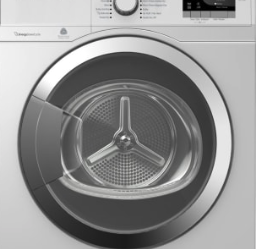Clothes dryers that don’t use natural gas or propane are usually lumped together as “electric”, without much additional consideration for performance differences. However, as we increasingly transition to all-electric homes and have higher expectations for our appliances, it’s time to be more nuanced in our discussions about dryers.
Vented vs. Ventless
Typical electric dryers in the US are vented and function by creating very hot air in the dryer drum, basically baking the clothes to dry them out. Hot air is exhausted to the exterior.
The other category of dryers is ventless.
Ventless dryers have a condensing coil and function by running very cold fluid through the coil and pulling moisture out of the air (creating condensation on the coil) before it goes into the drum with the laundry. The ultra-dry air then draws moisture from the wet fabric with very low heat, which uses less energy and is better for your clothes.
Although all ventless dryers function with the condensing coil, there are two types within this category:
• Condensing dryer: non-refrigerant condenser; typically requires more air volume surrounding the appliance
• Heat pump dryer: hermetically sealed refrigerant cycle and usually a secondary heat exchange; more efficient and usually costs a little more
Ventless Dryer Considerations
As the name suggests, no exhaust air needs to be vented to the exterior, which eliminates the need for a hole in the wall or roof. On the other hand, you do need a place for the accumulated condensate water. This can simply be a drain that is tied into the washing machine drain line, or some units have a compartment that can be emptied manually.
The lack of a vent provides flexibility for locating the dryer, especially in remodels. But if you select the condensing dryer, make sure you have lots of capacity for air changes, such as a location in a garage or large laundry room, or in a closet with a fully louvered door.
Also, like any dryer, regular cleaning and maintenance is required for top performance. For ventless dryers, plan on routinely cleaning the condensing coil, or select equipment that is self-cleaning.
Note that because ventless dryers function without high heat, they do require more time to dry than a vented dryer, maybe 45 minutes rather than 30 minutes. The cost range is $800 - $1,200 or more. For comparison shopping, go to https://marketplace.pge.com for PG&E territory, or https://marketplace.sce.com/dryers/ for So. California Edison depending on your territory; search dryers and filter for “ventless”.




